Swami AYYAPPAN : UNTOLD
Pandalam Dynasty
The Pandalam Kingdom had its beginning around 904 AD when a scion of the declining Paandya Kingdom of Madurai in Tamil Nadu took refuge in Kerala when attacked by the Cholas.The Sasta Shrine at Sabarimala had been there from the time immemorial as the guardian deity of the people and rulers in and around the forest area.
Around tenth century- anarchy prevailed in those days in Kerala. People around Pandalam lived in perpetual fear of attack by Udayanan and his men who committed dacoit and murder. He built up many fortresses on the mountain of Talappara, Inchippara and Karimala in the forests of Pandalam. The temple of Sabarimala, where Dharma Sastha was worshipped from the very ancient past was on the route, a highway between Tamil Nadu and Kerala, along which merchants traveled. Udayanan used to plunder wealth from the travelers and the villages nearby. This amount of success made Udayanan so brutal, that he attacked the Dharma Sastha temple at Sabarimala. Udayanan and his men plundered the temple, destroyed the idol and murdered the priest. The son of the priest escaped. He wandered amidst the mountain ranges awaiting an opportunity to wreak the vengeance up on Udayanan. Jayanthan, son of the priest, distressed by the gruesome murder of his father, decided to take revenge by killing Udayanan and his band, and to rebuild the temple.
He continued his education with vengence and became a Master of all forms of warfare, he then went to the Kings of various states and asked for help in defeating Udayanan. The kings were very impressed by his valour but nobody was ready to help him and bear the brunt of Udayanan. This attitude of the kings disappointed Jayanathan and he went to Ponnambalammedu and started performing penance to please Lord Sasta.
The God takes human body
Meanwhile, Udayanan sent a marriage proposal to marry the princess of Pandalam which the king refused respectfully. Enraged by the King's denial he attacked the palace, plundered it and abducted the princess. Udayanan dumped her into a dark prison and gave her one month to make up her mind face demise. That night Lord Sastha appeared in her dream and informed that she will be soon rescued and Lord himself will take birth as her son. Concurrently Lord also appeared in the dream of Jayanthan, who was at Ponambalammedu and instructed him to rescue the princess and marry her so that he could take birth as their son. While the burglars with their booty were traveling through the mountain routes, the son of the priest made a lightning attack on them and set the princess free. Since she was missing for more than 21 days from the palace, the royal family considered her to be dead and performed all her last rites. So Jayanthan eventually married the princess and they settled in an inaccessible forest region (near the present Ponnambalamedu), engaging in intense austerities and meditation. They earnestly prayed to Lord Dharma Saastha for a son who would be able to fight Udayanan, destroy him and liberate Sabarimala Temple.
Soon the couple begot a child. The child was born on 14-01-1095 AD -they named the Child as -Aryan as blessed by Sastha. Aryan was Lord Sastha’s one of the prominent names. Jayanthan educated and trained Aryan in all fields of religion, science and military art. Aryan was given adequate training both in scriptures and warfare by his able father. It was the intention of the father to bring him up in perfect military discipline with sufficient background in spiritual matters. Aryan became extra ordinarily brave and intelligent.
When his father thought that it was the ripe time for him to be sent to his own palace. All details about his birth and bringing up were written in a letter addressed to the king of Pandalam. He sent the child to his uncle's palace. Of course the king felt over joyous when he came to know about his sister, believed to be lost for ever. When Aryan reached Pandalam everybody was delighted by his godly appearance. He defeated the best warriors in Kings Army, which made a great impact on the King;
Aryan Kerala Varman
Aryan grew up in the palace. Even in youth several extraordinary faculties became manifested in him. He was a dear to one and all. Arya was adorned the position of chief of the King’s Army and the king gave him the full powers to rule the state. He was given the title "Aryan Kerala Varman" - who was addressed as "Ayyan" "Ayyappan" - a name of reverence by the local people.
Inspite of taking care of the governance of the state, Ayyappan often went to the sabarimala forest in solitude in order to meditate and contemplate on his mission.
Ayyappan rides an elephant
Once, the King of Punjar state Manavikraman, was on a journey and was surrounded by dacoits in the jungles of Vandiperiyar (Today's Pulmedu). King Manavikraman fought to his extent but was over powered by the dacoits. He started praying to Goddess Meenakshi of Madurai and his prayers were answered when a young boy riding on an elephant came to rescue of the King. It was Ayyappa who was wandering in the jungle, who had tamed a wild elephant and riding on its back. Ayyappa saved the King Manavikraman of from the Dacoits of Udayanan’s Group. He gave a “Perambu” - cane as his representative and asked to King to proceed to his Palace without any fear.
Though only of Fourteen years of age, he proved his mettle both as an accomplished warrior and a born Yogi. So Ayyappan decided to proceed with the mission of his life - To destroy Udayanan and his gang and rebuild the Sastha temple. So Ayyappan decided to build a powerful army. He instructed to the citizens, to donate one child from each family for the sake of the Kingdom.
Mission
Ayyappa's aim was to seek military assistance
-to put an end to Udayana's attacks;
-to restore peace and happiness to the people;
-to renovate Sabarimala temple which was burned to ashes in Udayana's attacks .
For achieving these goals , he intented to travel from Kayamkulam to Ambalappuzha , Cherthala , Alangad and finally to the Pandya Kingdom .
When he went to Kayamkulam - the Raja was thrilled seeing Sree Ayyappa in person , about whom he was hearing day-by-day as a super human teen as well as a sentinal to his citizen.The Raja promised all the help and allowed Ayyappa to collect soldiers from the Kalaries in the Western regions of his Kingdom .
Building the Army
Just before Ayyappa's departure from Kayankulam, a messanger came to announce the attack of Vavar the pirate, in the coastal areas. Ayyappa was excited and joyful to start attack as early as anything , as Vavar himself arrived to gather his fortune! The Karanavar ( head ) of Mullasseril family , who was the minister as well as the bravest soldier of Kayamkulam Raja, was to assist Ayyappa in the attempt. Conquering both body and mind of Vavar and converting him as a disciple , Ayyappa , with the consent of the Raja , gathered the nearby Kalari leaders and soldiers in the vast, beautiful ground at Pullukulangara .
Then he visited Ambalappuzha and Cherthala and conducted similar meetings. Kadutha, who was a great warrior and an expert in mountain-warfare, was a dependant of Pandala Raja. He played an indispensable role in defeating the armies of Udayanan and rescuing several Pandya Kings. Therefore Ayyappan called Kadhutha to assist in the mission.
Ayyappa’s Army included warriors like Kochu Kadutha the master of Sword fighting, Talapara Villan and Talapara Mallan the perfect Archers and Vavar the warrior.
The preparation
While his stay at Cherthala , Ayyappa was in the Kalari of Cheeram Chira Mooppan. Mooppan' s daughter fell in love with Ayyappa. When this girl proposed her love, Ayyappa gave her advise and thus she could change her mind to a spiritual level. Meanwhile, the army was getting ready.
With Erumeli as a center point, Ayyapa nurtured a powerful army which could fight Udayanan’s army in a very short time with the help of Vavar, Kadutha, Villan and Mallan. Ayyappan, with his army, marched through the forests, but the first attack was not that successful. Enraged by this, Udayanan conspired with a group of Chieftains abducted Cheramoopan's girl and killed Moopan's daughter. So Ayyappan asked all the members to observe strict Vrutham before entering Sastha’s Poonakavanam. After the Vrutham for 56 days, they worshipped Kiratha Sastha at Erumeli for the victory in the war. All the army battalions started assembling at erumeli and in order to avoid suspicion, he ordered the troop to dress as tribal people.(present day Pettai thullal)
Before the final attack on Udayan, Ayyappa distributed the Army into three groups :
1) Alankat Yogam under the leadership of Vavar
2) Amalpuzha Yogam under the leadership of Kadutha
3) Pandalam Yogam under the leadership of Villan and Mallan
Ayyappa kept the central command of the three groups with himself and started the pursuit of Udayanan from three sides North, South and East. Due Ayyappa’s Strategy to the attack from three sides Udayanan was caught in a mouse trap there
As soon as the army entered the poonkavanam – Ayyappan was totally a different person; beholding the winsome lustre of His face , he was serene and totally blissful. He never touched even a weapon; instead he was just leading and the army followed him.
The army proceeded towards the hideouts around lnjipara, Karimala, Udumpara, etc. The Army released the Eastern ghats from the iron fists of Udayanan.
Very soon Ayyappan’s army, marched through the forests and annihilated Udayanan's army. Udayanan’s Army was no match for the Formidable Army of Lord Ayyappa and after a fierceful fight between the two Armies, Uadayanan was slayed by the hands of Kochu Kadutha at Karimala Kotta. Ayyappan's mission ended successfully.
When the royal entourage, proceeded near Sabarimala temple , Ayyappa instructed everyone to leave all the weaponry beneath a big banyan tree there, as carrying of weapons to a temple premises was a sacrilege. Accordingly, the sword, spears, clubs etc. were left at the foot of the banyan tree – today’s Saramkutti. Then the famous episode of killing Mahishasuri (Mahishi ) happens. There are numerous interpretation to this story which we can go into the next time.
After this, swami proceeded to Sabarimala Sastha temple, where Ayyappan's father Jayanthan and others were ready to install a fresh idol of Sastha. Right from the moment he stepped into the holy mountain, Ayyappa was in silence and meditation. Until the completion of the Srikovil and installation of the idol, Ayyappan sat on meditation at the place where today’s Manimantapam stands. On the first day of the month of Makaram when the sun moved from the zodiac of Dhanus to that of Makaram, the re-installation of the idol was ceremoniously conducted. Ayyappa did the reconsecration in Sabarimala temple. Soon after the ceremony was over, a holy flame was seen at Ponnambalamedu and no one saw the Prince Arya Kerala Varman - Ayyappan thereafter. It was only thus everyone realized the amazing truth that their lovable , gentle , ameable , merciful young prince was the incarnation ( avatar ) of Sri Dharma Sastha !
The Story
Some believe that the temple once housed a Buddhist deity, and that Sabarimala was once a Buddhist temple complex. However, it appears that prior to its Buddhist incarnation, the temple was an early Dravidian Saivite centre; The people of the forest worshipped their hill gods like Karineeli Amma and Chathan in this location. As the Buddhist came, they made some changes, erected some structures, again Haindavas took it up. therefore it has been a sacred spot of singular merit of at least three or four millennia. The pandala kingdom was basically from Tamil Nadu. They worshipped Sastha as their protective deity. Almost all villages had Sastha temples and the deity was the Guardian of the villages.
But facts say that Sabarimala was never conquered by Buddhist tradition. Buddhism was a virus eating up hinduism during a period of time but soon we took it back from them.
Unravelling the mystery: Is Sabarimala Ayyappa temple, previously a Lord Buddha shrine??
Lord Ayyappa holds his hands in a particular Mudra (symbolic gesture) where the index finger of the hand is kept joined with the thumb, leaving the other three fingers free. This symbolizes the steadfast aim of the devotee to achieve nirvana, by taking refuge in the three jewels (Triratnas), Buddha, Dharma and Sangha, the fundamental commitments of a Buddhist. So it’s a Buddha idol!
As thrusting a last nail to the box (empty one), they state that Kerala was a Buddhist centre during the period from 6th century to 10th century C.E and thus Sabarimala would definitely be a temple built by Kerala Buddhists which was later converted by Hindus renaming Buddha as Saastha or Ayyappa. Quite Interesting!
Now it is for us to dive deep and bag the facts before we haste into an alternate view, however amazing it may appear.
1) Starting with the assertion on name similarity, let us check what are the synonyms of word Buddha from Amarakosa itself – Sarvajna, Sugata, Dharmaraja, Thatagatha, Samantha bhadra, Bhagavan, Marajit, Lokajit, Jina, Sadabhijna, Dasabala, Advayavadi, Vinayaka, munindra, Srighna, Sasta, Muni, Sakya, Sakya Simha, Sarvarthasiddha, Sauddhodhani Gauthama, Arkabandhu, Mayadevisuta. These many words come as the synonym of the word Buddha. Indeed ‘Saastha’ is a synonym but that doesnt mean Saastha and Buddha are one and the same. In that case, another synonym is ‘Vinayaka’ and we never say Buddha and ‘Vinayaka’ are same.
Swami Ayyappa
The word Saastha comes from ‘Sas’ dhatu which means “Sashyathi” or to command. Refers to a person who commands, rules or teaches. The word Buddha in expanded form is “Yo Buddhavaan Sadaiva Njaathasthi sa Buddho Jagadeeshwaraha:” is the one who knows everything at all times, or the God almighty. So even though both these words can be used as synonyms, they signify two different aspects. To ensure more clarity, with a lighter note, shall we check a similar examples with a Malayalam word “Aaana” which means Elephant. A synonym for elephant in Malayalam is “Kari”. However ‘Kari’ actually means black charcoal.
So though ‘Aana’ and ‘kari’ are synonyms, both are totally different in their meanings and representations. So the name similarity do not ring any bell at all, of similarity of the two deities!
2) The strict austerities, renunciation and abstinence followed which could be of Buddhist origin.
Very wrong! If the propagators of this theory would at least have read the story of Gauthama Buddha! Lord Buddha in search of the truth undertake different kinds of austerities and strict disciplines in his life which itself is a proof that this did exist prior to the spread of Buddhism. The practices resemble more closely to the Yama Niyamas of the Ashtanga Yoga Darsanam.

Sage Patanjali- founder of Ashtanga Yoga
Ashtanga Yoga is one of the famous philosophical treatise (view) practiced even today across the world. As the name suggests it has ‘Ashta’ – eight , ‘Anga’ – limbs which are very essential. The path ultimately leads man to divinity but in order he has to attain mastery over the 8 parts of this philosophical exposition. The first two steps are ‘Yama’ and ‘Niyama’ which advocates the spiritual aspirant to follow certain things like following austerities, refraining from worldly pleasures etc.
Not just Ashtanga Yoga, if you refer Hindu scriptures, you shall find countless Hindu Saints recommending the spiritual devotees to live a simple life renouncing worldly temptations and the whole objective of doing this is to keep the mind focussed on the inner self rather than on the much distractive outward things. Now we know from where the strict spiritual practices of the Sabarimala pilgrim would have come?
3) Sabarimala Pilgrims constantly chants “Sharanam”, the same word is a characteristic word of Buddhism.

Pilgrims chanting sharanam and climbing Sabarimala hill
Well, not really!
The Editor of Journal of Indian History (Volume 18, page 117) says this expression of Sharanam is common in Hinduism too whenever someone appeal to God for his/her Grace. In his own words, “It is not so clearly established that the idea of seeking the protection of a saviour is an idea peculiar to the Buddhists or originated with the Buddha and the Buddhist teacher. No doubts the Buddhists have the notion of the ‘Trisaranam’ but that does not necessarily mean that that is the earliest of the first.”
We can observe the usage of “Sharanam” even as far back in Rig Veda which was written many a years before the time of Lord Buddha himself.
“Indrathridhathu Sharanam”(6.46.9)
Durga Sooktham starts with taking refuge in Durga and we could see that the word “Sharanam” is used.
“Thisro Devi: Swadhaya Barhiredhamachidhram panthu Sharanam nishadya” (2.3.8.)
We could also see the usage of “Sharanam” in many other Puranic Scriptures too. So a more relevant question that we could pose to a curious self is whether the Sharanathrayam (Trisharana’s) of Buddhism, borrowed from the Hindu scriptures?
4) Buddhists preferred to live in secluded places.
What do we then say about 100’s of Saastha shrines that exists even now amidst cities, towns and villages? Not to mention, forests were places of worship and meditation for several Hindu saints and Rishis as well.
5) There is/was no caste discrimination in Sabarimala temple; which only Buddhists promote! Also, pilgrims calling each other ‘swami’ in respect and equal vision.
The basic philosophy of Hindus is to realize the divinity in oneself. Ultimately one would recognize himself with the whole of creation. So even when the caste systems that existed in the social life were very rigid, for a spiritual aspirant seeking the ultimate destination and meaning of life, there was divinity and divinity only , not just in fellow beings, but in all creations of this universe. So this was not an alien philosophy for Hindus to respect and address each other as divine (swami) and treat them without any caste bias.
Keeping the blame of the Social system that existed through caste divisions in India, on the head of whole of Hinduism, is another major matter to debate which shall be discussed elsewhere.
6) Ayyappa and Buddha both are in sitting postures.
Ayyappa in Sabarimala sits comfortably in a meditating yogic posture known as “Yogabhattaasanam”. There are other Hindu Gods who sit in the same yogic posture like Yoga Narasimhamoorthi, Yoga Dakshinamoorthy etc. Their pictures revealing the similarity of posture is given below:
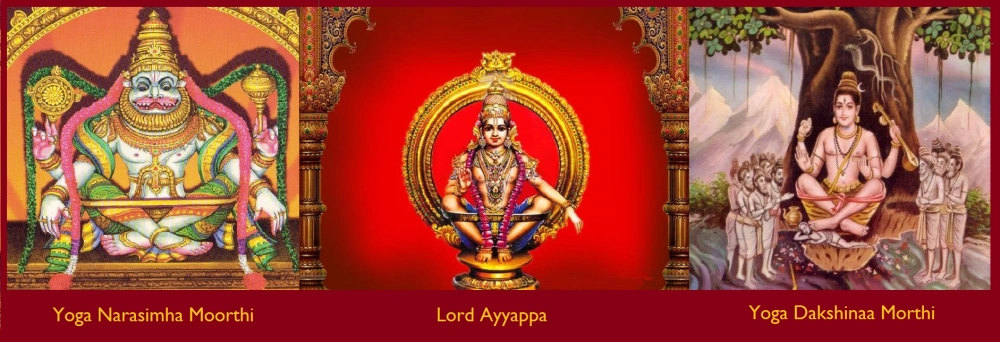
There are no reporting’s of any Buddha statue, where he sits in this particularly rare asana (posture), considering thousands and thousands of Buddha statues that were excavated and preserved from most Asian countries. Also, majority of sitting Buddha statues have the lord sitting in “Padmasana” or the lotus posture.
There are numerous images of Saastha in Travancore and nearby and we have not come across any Saastha image strictly conforming to the features of Buddha. (Selected essays: Raja Raja Varma, page 152)

Most Buddha idols have the lord sitting in Padmasana
Let us drill down one step further and check for the descriptions of lord Gauthama Buddha and Saastha as expounded by Buddhist and Hindu scriptures. Description of Saastha image is given in Amsumabhedagama, Suprabedhagama, Karanagama. None of these authorities match with that of Buddha. Neither does any Saastha images in Kerala conform to the features prescribed for Buddha.
7) The Mudra held by Ayyappa, Is Chinmudra.
Mudra is the way in which the hands are held. This is the mudra from Tantra which is famous for Wisdom of Adwaita (non duality) while the Yogabhattasana of Ayyappa denotes intense tapas. The first Guru of Hindus, Aadi Dakshniamoorthi is said to have preached his teachings of Vedanta philosophies through Chinmudra. Also while preaching the Bhagavat Gita, lord Krishna was believed to have held his hands in Jnana Mudra (Jnana mudraya Krishnaya Gitamrita Duhe namah: – Dhyana sloka of B.G).
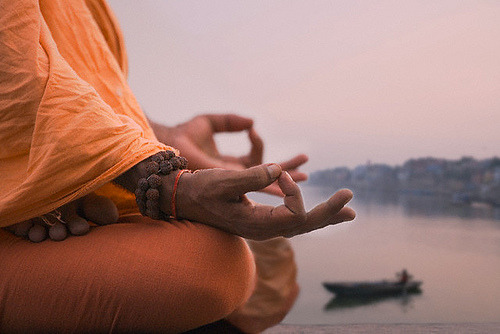
A hindu monk meditating with his hands in Chinmudra
8) Chinese traveller Huan Tsang mentioned about this as a Buddha temple!
The travel route of Huan Tsang pronounced originally as XuanZang in Chinese is available.

Kindly refer and yell in wonder how a person who never visited anywhere near Kerala would have given narrations on a temple that exists in Kerala.
9) Kerala was a Buddhist centre and thus this temple would have been built by Buddhas and was later converted by Hindus.
Even now there are no traditions or legends associated with the stories of lord Buddha. None of the ancient Kerala records narrates about Buddhism, may be because Kerala was a state formed very late. Even the earliest works in Tamil, ‘Tolkappiyam’ and ‘Thirukkural’ do not refer to Buddhism. Early reference to Buddhism in texts come from “Silapadikaaram’ and Manimekalai’ in Tamil. There are Buddhist images excavated at Kiliroor and Nilamperoor etc and also vestiges in Travancore. There are previous studies done into the spread of Buddhism in Kerala (Buddshim in Kerala: P.C. Alexander) which shows the below given map to show Buddhist centres in Kerala.
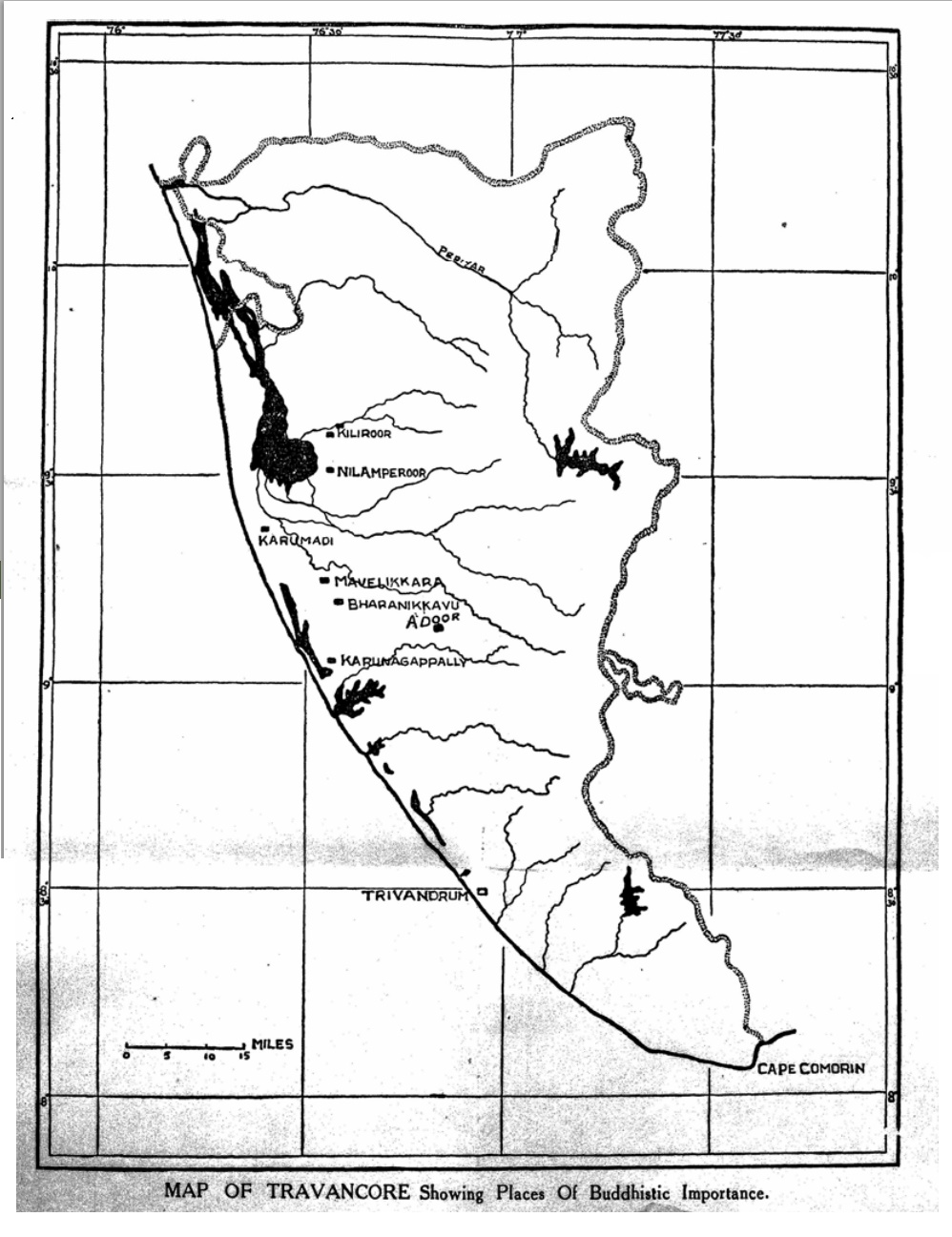
It is true that many parts of Kerala had Buddhist centres for many centuries even, but that doesn’t mean in any way that Buddha and Saastha are the same. At most, if the argument was like, the Buddhist traditions in Kerala influenced the Sabarimala temple or rituals, then, there would even be some space for a healthy discussion.
Thus refuting these 9 questions posed by the alternate historians, let us ponder over some more irresistible probes.
Keralolpathi says that Saastha was made as the guardians of the eastern slopes and was propitiated for the defence of the land from foreign invasions. How could a peace loving Guru like Buddha whose most important teaching is ‘Ahimsa’ or non violence, can be a defence commander?
Saastha is a deity who take special interest in warfare. Yatrakkali, Chathirakkali, Sanghakkali, Panakkali are plays in Malabar to propitiate deities like Saastha and Durga. During Sharanam calls, Saastha is addressed as ‘Villaaliveeran”, Veeramanikandan” etc which extols the valour, courage and braveries of a dedicated soldier. Saastha was the presiding deity in most of village kalariesor fencing schools. Sodiers used to enter war only after formal puja to the war deities and chief of which was Saastha. These practices are there from ancient time. This is a strong disagreement to Saastha Buddha comparison. Saastha who took delight in warfare while Sakhyamuni who preached ahimsa are certainly not same.
Further reads:
- Buddhism in Kerala – P.C. Alexander
- Hindu Temples: What happened to them? Vol 11 – Chapter 4 – Sita Ram Goel
- Article from magazine Kesari published on January 2015 (malayalam)
- Blog (in Malayalam) : http://goo.gl/QmXfxc
- https://historicalcontroversies.wordpress.com/tag/is-sabarimala-buddha-temple/
Maha Sastha Sthuthi
Sithi hayamadeeruhya sancharantham,Sritha jana chinthitha poorane pravrutham,
Hithakaramanisam sadhaam mahantham,
Sathathamaham Brahadeeswaram prapadhye. 1
I always salute that God who is very great,
Who travels in a blue coloured horse,
Who fulfills wishes of devotees coming to him,
Who is partial to sages and is always greatest.
Hariharathanu sambhavam supoornam,
Suramuni chitha janaischa vandhyamaanam,
Varasithama vaaranedrayaanam,
Sathathamaham Brahadeeswaram prapadhye. 2
I always salute that God who is very great,
Who was made possible by Lord Vishnuand Shiva,
Who is complete, who is saluted by Sidhas and men,
And who travels on a white exuberant elephant.
Vanabhuvi mrugaayaam sada charantham,
Dhanujaa kulathakarodhya thoru kundam,
Kanakamani vichithra bhooshanam tham,
Sathathamaham Brahadeeswaram prapadhye. 3
I always salute that God who is very great,
Who always hunts animals that wander in the forest,
Who is the reason for destruction of clans of asuras,
Who is armed with a spear and who is ornamented,
With several ornaments made of very rare gems and gold.
Sarad amala sudhamsu bimba vakthram,
Dharani sudhaakara veedhi hothra nethram,
Sura tharu suma bhooshidhoru gathram,
Sathathamaham Brahadeeswaram prapadhye. 4
I always salute that God who is very great,
Whose face is similar to the face of moon of spring,
Who looks at earth with moon like eyes,
And whose limbs are decorated by divine flowers.
Vanabhuvi sanakadhi sevyamaanam,
Manujavarai ranisam prapoojyamaanam,
Jananamruthivihinathaam dhadhaanam,
Sathathamaham Brahadeeswaram prapadhye. 5
I always salute that God who is very great,
Who is being praised by sages like Sanaka in the forest,
Who is always worshipped by noble among humans,
And who removes the fears of birth and death.
Pranavatharu vihangamadhi devam ,
Gunamaya samsmruthikananorudhavam,
Ganapathi guha sannudha prabhavam,
Sathathamaham Brahadeeswaram prapadhye. 6
I always salute that God who is very great,
Who lives in the tree of Om like a bird,
Who is the fire which destroys the dark forest of birth and death,
And who is the one who is praised by Lord Ganapathi and Subramanya.
Suraparibrooda sevathangri yugmam,
Guru mahivathma drusaam vishuddha thathwam,
Giri guha rathalesu sannivishtam,
Sathathamaham Brahadeeswaram prapadhye. 7
I always salute that God who is very great,
Whose two feet are served by all devas including Indra,
Who is the form of purity that is the teacher of all,
And who has positioned himself in the cave in the mountain.
Ajama maranadhipam varishtam,
Gaja ripu prushtakathoru rathna peedam,
Vijitha madana sundaram garishtam,
Sathathamaham Brahadeeswaram prapadhye. 8
I always salute that God who is very great,
Who is the noble God who has won over death,
Who sits on a gem studded seat on a lion,
Who is great and wins in beauty, that God of love.
Ithinathi mathulaam Mahesa soono,
Hrudhi nitharamanu chinthayan swaroopam,
SAdhu pasu sitha sampadhaam nivasam,
Pari padathe brahadheeswara prasadaath. 9
If one reads this story of the son of shiva,
Meditating in the mind his form,
Due to blessings of the great God,
He would be blessed with wealth , sons and home.
The combination of the first two that is Shiva and Shakthi gives Ganesha and Karthikeya/Arumukhan ( 6 faced god). Lord Karthikeya stands at the 6th position. Then the combination of the first and the third, that is Shiva and Vishnu ( the male form of Shakthi/ Mahamaya) gives Sasta.
The famous Sastha Varavu song, “Ettu Avadharangal Undu, Yettu Swaroopangal Undu” suggests eight important incarnations and eight forms of Sastha ; and ‘Dyana ratnavali’ confirms the same fact.
Ancient deity Sastha was an ancient deity worshipped thousands of years ago across the globe. There are references to Sastha worship in the submerged Lemuria, Vietnam and Africa. There is a Sastha Hill in California, the U.S.
Adhi Maha Sastha is worshipped with two consorts – Poorna and Pushkala. He is worshipped in many villages of South, as a protector of their houses and cities. He is also offered prayers to help find missing/lost items. His grace helps us receive rainfall on time, makes our water and land resources fertile and thereby enhancing crop cultivation. It is believed that Karikaala Chozhan, an ardent devotee of this Sastha , won many battles after worshipping Sastha in Kanchi Kamakshi Amman temple.
The north Indian connection
The Sabarimala temple is also connected to Lord Rama. The name Sabarimala is derived from Shabari, a tribal devotee of Lord Rama mentioned in the Ramayana. Sabarimala literally means the hill of Sabari. Lord Rama had come to meet Shabari as her Guru Rishi Matanga had predicted. The Sabarimala temple complex has a temple of Lord Rama and Hanuman too
The Sabarimala temple is also connected to Lord Rama. The name Sabarimala is derived from Shabari, a tribal devotee of Lord Rama mentioned in the Ramayana. Sabarimala literally means the hill of Sabari. Lord Rama had come to meet Shabari as her Guru Rishi Matanga had predicted. The Sabarimala temple complex has a temple of Lord Rama and Hanuman too
Om Namah Shivaya ...
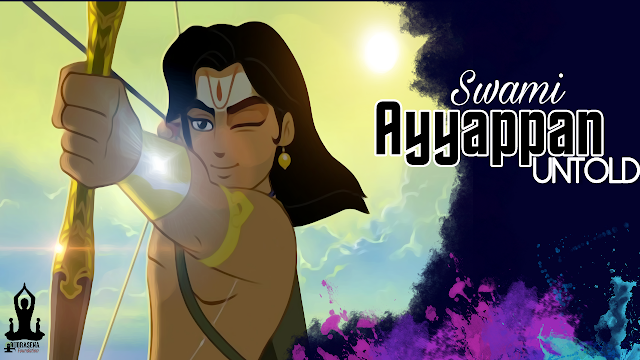











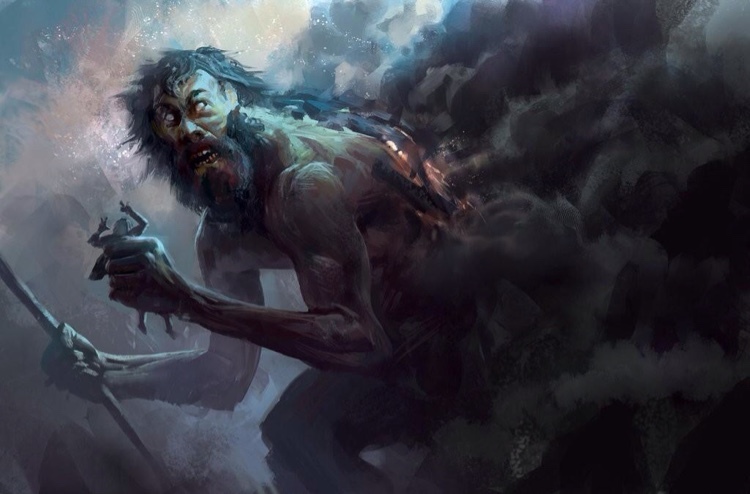


Comments
Post a Comment